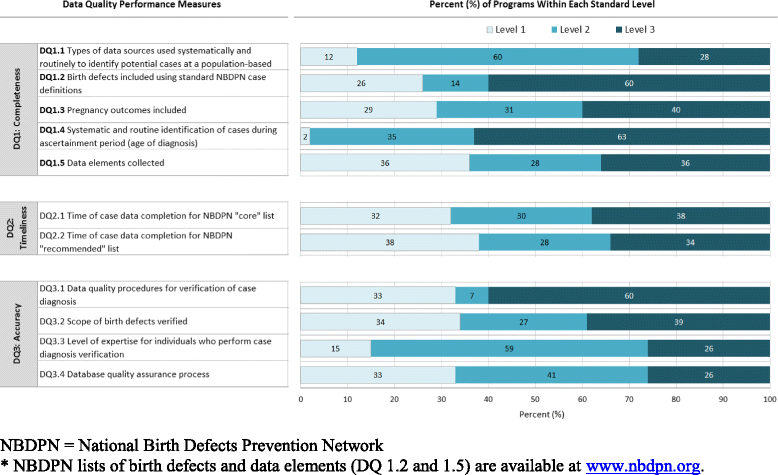Development and implementation of the first national data quality standards for population-based birth defects surveillance programs in the United States
- PMID: 26386816
- PMCID: PMC4575466
- DOI: 10.1186/s12889-015-2223-2
Development and implementation of the first national data quality standards for population-based birth defects surveillance programs in the United States
Abstract
Background: Population-based birth defects surveillance is a core public health activity in the United States (U.S.); however, the lack of national data quality standards has limited the use of birth defects surveillance data across state programs. Development of national standards will facilitate data aggregation and utilization across birth defects surveillance programs in the U.S.
Methods: Based on national standards for other U.S. public health surveillance programs, existing National Birth Defects Prevention Network (NBDPN) guidelines for conducting birth defects surveillance, and information from birth defects surveillance programs regarding their current data quality practices, we developed 11 data quality measures that focused on data completeness (n = 5 measures), timeliness (n = 2), and accuracy (n = 4). For each measure, we established tri-level performance criteria (1 = rudimentary, 2 = essential, 3 = optimal). In January 2014, we sent birth defects surveillance programs in each state, District of Columbia, Puerto Rico, Centers for Disease Control and Prevention (CDC), and the U.S. Department of Defense Birth and Infant Health Registry an invitation to complete a self-administered NBDPN Standards Data Quality Assessment Tool. The completed forms were electronically submitted to the CDC for analyses.
Results: Of 47 eligible population-based surveillance programs, 45 submitted a completed assessment tool. Two of the 45 programs did not meet minimum inclusion criteria and were excluded; thus, the final analysis included information from 43 programs. Average scores for four of the five completeness performance measures were above level 2. Conversely, the average scores for both timeliness measures and three of the four accuracy measures were below level 2. Surveillance programs using an active case-finding approach scored higher than programs using passive case-finding approaches for the completeness and accuracy measures, whereas their average scores were lower for timeliness measures.
Conclusions: This initial, nation-wide assessment of data quality across U.S. population-based birth defects surveillance programs highlights areas for improvement. Using this information to identify strengths and weaknesses, the birth defects surveillance community, working through the NBDPN, can enhance and implement a consistent set of standards that can promote uniformity and enable surveillance programs to work towards improving the potential of these programs.
Figures
References
-
- Centers for Disease Control and Prevention (CDC) Update on overall prevalence of major birth defects--Atlanta, Georgia, 1978–2005. MMWR Morb Mortal Wkly Rep. 2008;57(1):1–5. - PubMed
-
- Mathews TJ, MacDorman MF. Infant mortality statistics from the 2010 period linked birth/infant death data set. Hyattsville, MD: National Center for Health Statistics; 2013. p. 8. - PubMed
MeSH terms
Grants and funding
LinkOut - more resources
Full Text Sources
Other Literature Sources
Medical


